全文HTML
--> --> -->目前, 研究者们主要将目光聚焦于以下两类材料. 第一类为黑磷的等电子体, IV-VI族MX (其中M = Ge, Sn; X = S, Se)型化合物, 如GeS[22,23]和SnSe[24]等. 第二类是极少部分特殊的过渡金属硫族化合物, 如ReS2和ReSe2等. 它们的光学[22,25]、振动[26]、热学[27,28]和电子传输[29,30]特性均具有强各向异性的特点, 使其在传感器和电子设备中都具有广阔的应用前景. 但是这两类材料的禁带较窄(<2 eV), 导致工作波段受限. 因此, 非常有必要探索宽禁带的各向异性二维材料.
近年来兴起的各向异性半导体GeSe2, 由于其具有宽禁带的优势, 获得了众多****的广泛关注[31]. 华中科技大学翟天佑团队[32]通过化学气相沉积法成功制备了7 nm (约10层)的GeSe2纳米片, 并基于该材料的大吸收系数实现了具有高响应度和快速响应的GeSe2的光电探测器. 中国科学院化学研究所的胡劲松团队[33]通过机械剥离法得到了3.5 nm (6层)的β相GeSe2, 其在短波区域表现出高度偏振相关的光电响应, 并且在空气环境中有较好的稳定性. 作为一种典型的IV-VI族化合物, 相比于α相和γ相, β相的GeSe2是最稳定的. 该相的GeSe2体态带隙为2.7 eV, 而单层带隙可以达到3 eV. 在光学特性方面, GeSe2的吸收系数可达104 cm–1, 光电探测器的开关比可超过102[34]; 在电学特性方面, 掺杂后的GeSe2空穴迁移率可以达到690 cm2·V–1·s–1[35], 光电响应度可达2.5 A·W–1, 且上升沿与下降沿响应时间为0.2 s[32]. 上述表明了GeSe2有着优良的线性光学和电学特性, 但截至目前, 该材料的光学非线性特性暂未发现有团队报道过. 而宽带隙各向异性半导体材料一般有着较优良的非线性光学响应[24]. 基于此, 本文的工作主要围绕GeSe2的非线性光学效应展开.
本文对GeSe2纳米片在近共振吸收峰附近的非线性光学吸收特性进行了研究. 首先通过偏振选择的拉曼光谱表征GeSe2纳米片晶轴取向, 并利用偏振选择的线性吸收谱对其各向异性能带进行表征, 得到其共振波长在450 nm (2.72 eV)附近. 进一步, 为了研究GeSe2纳米片在共振能带附近的非线性吸收模式, 本文使用偏振可调的微区I扫描系统对其进行测试. 结果表明, GeSe2中非线性吸收模式为饱和吸收与激发态吸收的叠加吸收状态, 且对入射光偏振与波长均有强烈的依赖, 尤其是激发态吸收. 在450 nm近共振激发时, 随着入射光偏振的不同, 非线性吸收调制深度可由4.6%变化至9.9%, 其动态调制深度(不同偏振激发下的调制深度差)为5.3%; 而在400 nm非共振激发时, 调制深度由7.0%变化至9.7%, 动态调制深度仅2.7%. 其中, 相比于饱和吸收, 激发态吸收模式的偏振依赖程度对波长更为敏感, 这是动态调制深度对波长有较大依赖的主要原因. 本文为GeSe2纳米片各向异性非线性光学特性的应用打下了理论基础, 为全光开关的实现提供了一种偏振调控的方案.

光学非线性吸收实验采用的是偏振可调节的微区I扫描系统. 其中, 由钛宝石激光器(Spectra-Physics, 35 fs, 800 nm, 1 kHz)输出的飞秒激光经过光学参量放大器(TOPAS)转换到实验所需波长(400 nm & 450 nm, 1 kHz), 并通过中性密度滤光片(Thorlabs, NDL-10C-4)连续改变光强, 实现I扫描. 入射激光的偏振方向由半波片和格兰棱镜组合进行调节, 以15°为步长旋转180°. 激光由共焦显微镜(徕卡DM 2700M)以及宽范围波长物镜(Mitutoyo 50×, NA = 0.65, 400—1700 nm)在样品表面聚焦为直径2 μm的光斑. 在信号检测方面, 使用斩波器(Thorlabs, MC2000 B-EC)将光的重复频率调制到500 Hz, 与双通道锁相放大器(Sine Scientific Instrument, OE1022D)组合, 降低测试噪声.
3.1.GeSe2的制备和表征
图1(b)为GeSe2薄片的AFM图. 可以看出, 样品厚度为88 nm, 表面平整, 符合实验要求. 样品偏振相关的拉曼光谱如图1(c)所示, 在波数为118, 212, 251和307 cm–1处分别有4个拉曼峰, 对应着β-GeSe2的典型Ag振动模式[19,32]. 为了定量研究拉曼强度的偏振相关性, 将四种典型拉曼模式的强度绘成极坐标图, 并且引入经典Placzek模型对结果进行拟合和解释. 拉曼强度可以表示为

















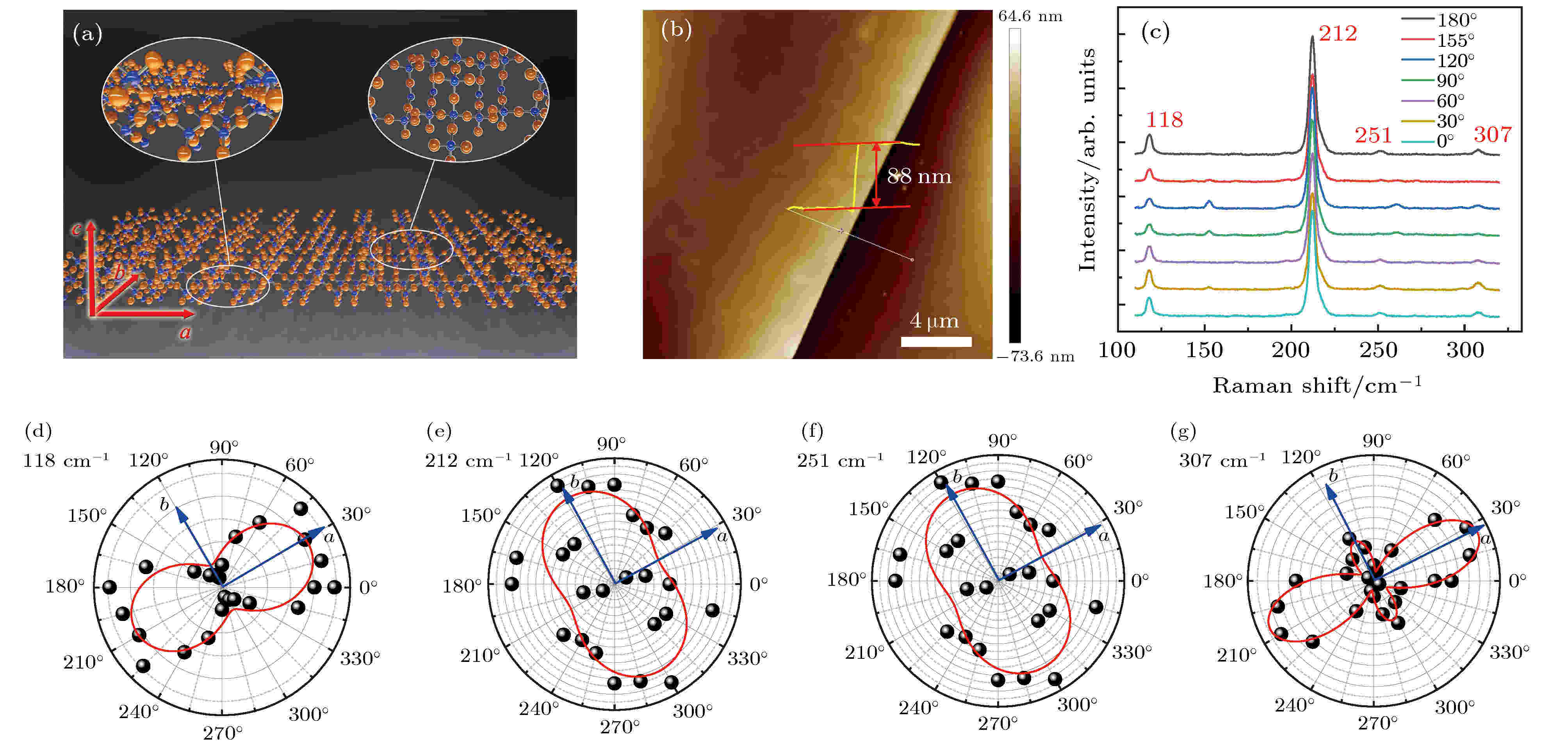 图 1 (a) GeSe2原子结构示意图; (b) 机械剥离GeSe2纳米片的AFM图, 样品的厚度为88 nm; (c) 偏振选择的拉曼光谱, 其中4个拉曼峰位置分别在118, 212, 251, 307 cm–1; (d)—(g) 4个拉曼峰强度分别对应的极坐标示意图
图 1 (a) GeSe2原子结构示意图; (b) 机械剥离GeSe2纳米片的AFM图, 样品的厚度为88 nm; (c) 偏振选择的拉曼光谱, 其中4个拉曼峰位置分别在118, 212, 251, 307 cm–1; (d)—(g) 4个拉曼峰强度分别对应的极坐标示意图Figure1. (a) Schematic diagram of the atomic structure of GeSe2; (b) AFM image of GeSe2 flake by mechanical exfoliation. The thickness of the sample is 88 nm; (c) polarization-dependent Raman spectrum. Four Raman peak positions are at 118, 212, 251, 307 cm–1, respectively; (d)–(g) polar diagrams of the intensity of the four Raman peaks.
2
3.2.偏振相关线性吸收谱表征GeSe2的能带
线性吸收谱可用于表征二维材料在不同光谱区域吸收光子的能力分布, 从而间接推断出材料的能级位置, 为光学非线性吸收测试的波长选择提供参考依据. GeSe2纳米片的线性吸收谱如图2(a)所示. 总体而言, 样品对各偏振方向的激光, 线性吸收率均由360 nm波长位置处的40%—50%先下降至420 nm处的约5%, 而后呈现上升趋势; 对于不同偏振方向的激光, 线性吸收率在波长小于380 nm和波长大于410 nm的区域相差较大, 而在400 nm处差异最小.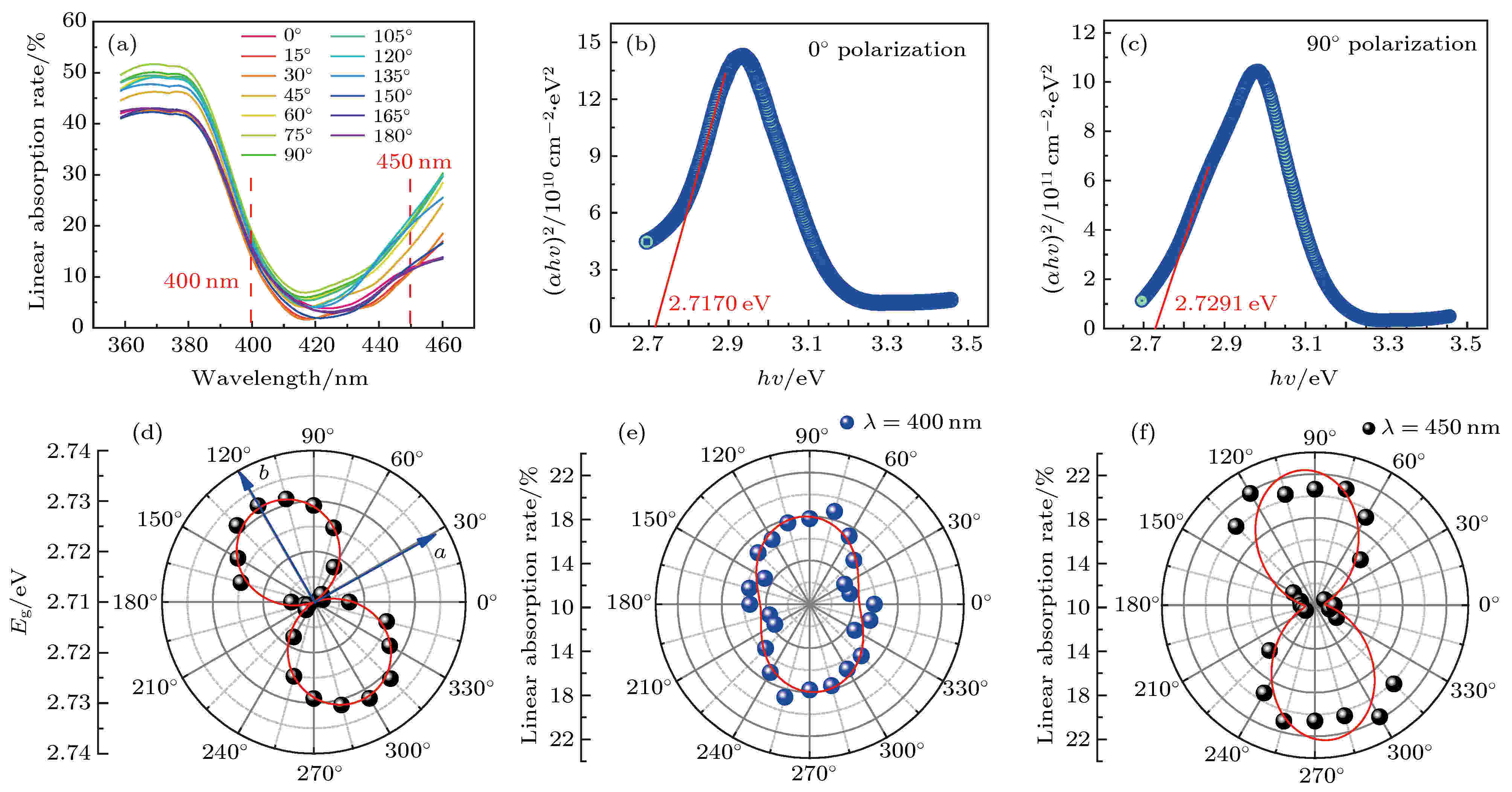 图 2 线性吸收谱对层状GeSe2的各向异性能带表征 (a) 0°—180°偏振方向的线性吸收谱, 其中间隔15°; (b) 0°偏振方向的能带确定; 由陶克定理间接得到的能带位置, 其中切线与横坐标交点位置为2.717 eV; (c) 90°偏振方向的能带确定; 由陶克定理间接得到的能带位置, 其中切线与横坐标交点位置为2.7291 eV; (d) 层状GeSe2的各向异性能带; b轴方向上的带隙最大, 而a轴方向的带隙最小; (e) 层状GeSe2在400 nm处的各向异性线性吸收率极坐标图; (f) 层状GeSe2在450 nm处的各向异性线性吸收率极坐标图
图 2 线性吸收谱对层状GeSe2的各向异性能带表征 (a) 0°—180°偏振方向的线性吸收谱, 其中间隔15°; (b) 0°偏振方向的能带确定; 由陶克定理间接得到的能带位置, 其中切线与横坐标交点位置为2.717 eV; (c) 90°偏振方向的能带确定; 由陶克定理间接得到的能带位置, 其中切线与横坐标交点位置为2.7291 eV; (d) 层状GeSe2的各向异性能带; b轴方向上的带隙最大, 而a轴方向的带隙最小; (e) 层状GeSe2在400 nm处的各向异性线性吸收率极坐标图; (f) 层状GeSe2在450 nm处的各向异性线性吸收率极坐标图Figure2. Characterization of anisotropic bands of layered GeSe2 by linear absorption spectrum: (a) Linear absorption spectrum with polarization directions from 0° to 180° with intervals of 15°; (b) the energy band of the 0° polarization direction is determined. The band position obtained indirectly from Tauc’s theorem, where the position of the intersection of the tangent and the abscissa is 2.717 eV; (c) determination of the energy band of the 90° polarization direction. The band position obtained indirectly from Tauc’s theorem, where the position of the intersection of the tangent and the abscissa is 2.7291 eV; (d) anisotropic energy bands of layered GeSe2. The band gap in the b-axis direction is the largest, and the band gap in the a-axis direction is the smallest; (e) polar graph of anisotropic linear absorptivity of layered GeSe2 at 400 nm; (f) polar graph of anisotropic linear absorption of layered GeSe2 at 450 nm.
为了对能隙进行定量表征, 接下来使用陶克模型(Tauc model)对不同偏振激发下样品的线性吸收谱进行拟合,

如前所述, 波长400 nm (非共振区域)附近, 样品对不同偏振激光的线性吸收率差异最小(约4%), 而在450 nm (近共振区域)处差别较大(约10%), 如图2(e)和图2(f)所示. 一般来说, 非线性吸收的偏振依赖性与线性吸收谱的各向异性密切相关[24], 故选用400和450 nm波长的激光, 研究GeSe2纳米片的偏振相关光学非线性吸收特性.
下面进一步分析层状GeSe2的线性吸收依赖于入射光偏振的原因. 基于费米黄金定则, 跃迁速率为单位时间内由初态i跃迁到终态f的概率[24]:




2
3.3.GeSe2中的各向异性非线性光学响应
接下来利用I扫描技术对GeSe2的偏振相关的非线性光学吸收特性进行详细研究. 非线性光学特性的常用研究手段包括Z扫描技术和I扫描技术[3,38,39], 前者通过样品在光轴方向的位移Z改变光斑半径大小, 从而获得连续变化的光功率密度[40], 而后者则是通过1/2波片加格兰棱镜或者衰减片, 直接改变入射激光的光功率达到相同效果[10]. 由于Z扫描技术中光斑大小随样品移动而不断变化, 对于大多数机械剥离的样品而言, 光斑极可能超出样品区域, 无法保证测试的准确性. 本文将传统的I扫描系统改进为微区I扫描系统, 提高了信噪比的同时将光斑大小控制在5 μm以内, 适用于机械剥离样品的测试.首先用400 nm飞秒激光入射GeSe2样品, 激光偏振以15°为步长旋转180°, 实验结果见图3(a), 为显示清晰, 仅给出间隔30°的数据外加90°附近两个数据. 400 nm激光的光子能量(3.1 eV)大于GeSe2的带隙(约2.73 eV), 通常呈现饱和吸收特征, 即当高峰值功率激光入射材料时, 由于价带电子不断吸收光子跃迁进入导带, 可供激发的电子减少, 导带能态逐渐被占满, 材料吸收系数

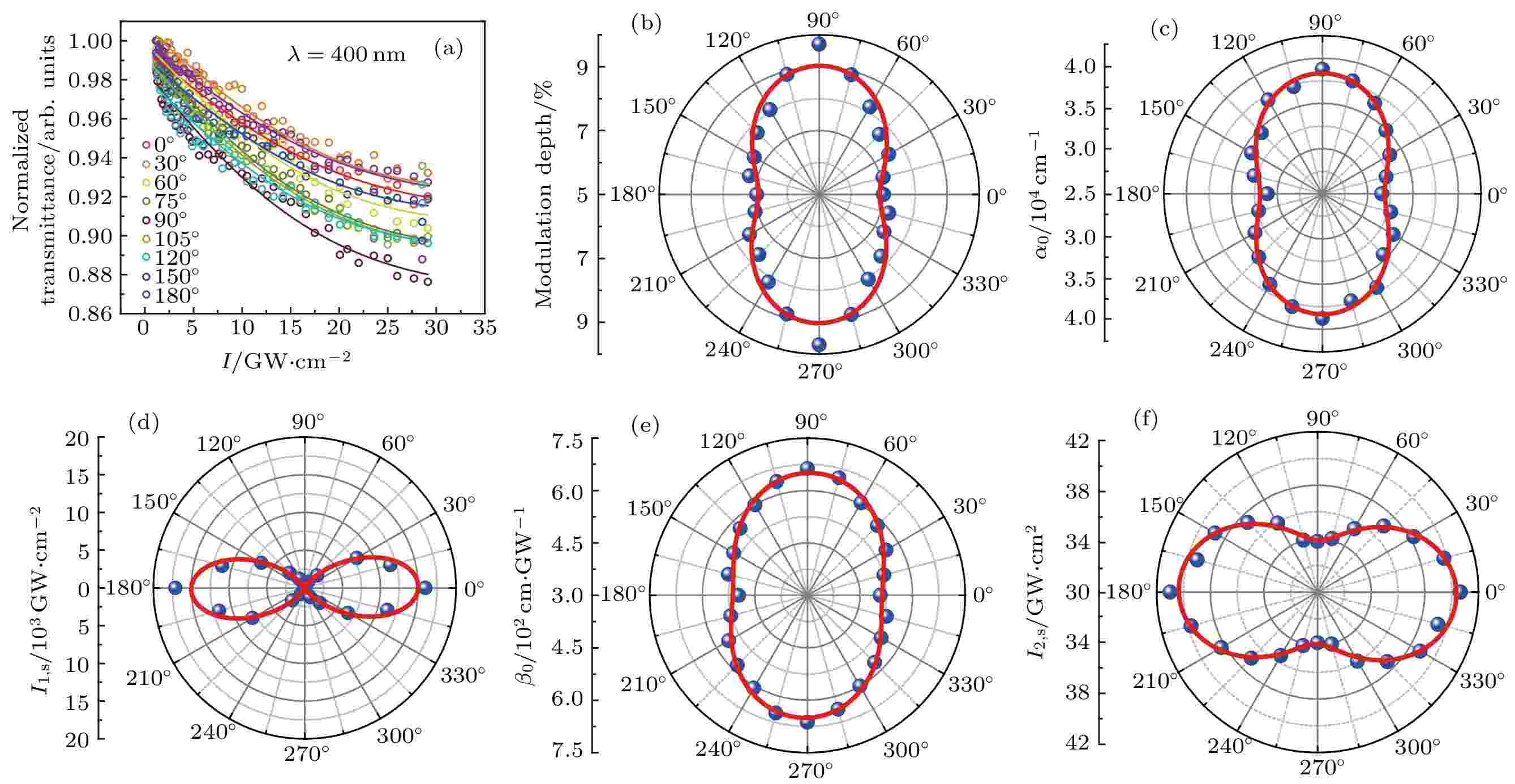 图 3 400 nm非共振激发下不同偏振方向的叠加态吸收实验结果 (a) I扫描实验结果, 圆圈表示实验数据, 实线表示激发态吸收拟合曲线; (b) 偏振相关的非线性调制深度极坐标图; (c) 偏振相关的线性吸收系数α0变化趋势极坐标图; (d) 偏振相关饱和吸收光强I1,s极坐标图; (e) 偏振相关的激发态吸收系数β0变化趋势极坐标图; (f) 激发态吸收的偏振相关饱和光强I2,s极坐标图
图 3 400 nm非共振激发下不同偏振方向的叠加态吸收实验结果 (a) I扫描实验结果, 圆圈表示实验数据, 实线表示激发态吸收拟合曲线; (b) 偏振相关的非线性调制深度极坐标图; (c) 偏振相关的线性吸收系数α0变化趋势极坐标图; (d) 偏振相关饱和吸收光强I1,s极坐标图; (e) 偏振相关的激发态吸收系数β0变化趋势极坐标图; (f) 激发态吸收的偏振相关饱和光强I2,s极坐标图Figure3. Experimental results of superposition state absorption of different polarization directions under 400 nm non-resonant excitation: (a) Results of the I-scan experiment. The circles indicate the experimental data, and the solid lines indicate the excited state absorption curve; (b) polarization-dependent non-linear modulation depth polar plot; (c) polar plot of the change in polarization-dependent linear absorption coefficient α0; (d) polarization diagram of polarization-dependent saturated absorption intensity I1,s; (e) polarization diagram of the polarization-dependent excited state absorption coefficient β0; (f) polarized graph of polarization-dependent saturation light intensity I2,s absorbed by the excited state.
基于比尔-朗伯定律, 光经过一个厚度为z的光学介质后, 光强I的变化为



















| Polarization/(°) | α0/cm–1 | β0/cm·GW–1 | I1,s/GW·cm–2 | I2,s/GW·cm–2 | δT/% |
| 0 | 31559 | 508 | 15947 | 41 | 7.0 |
| 30 | 33593 | 559 | 7962 | 38 | 7.5 |
| 60 | 36579 | 606 | 972 | 35 | 8.2 |
| 90 | 38790 | 663 | 349 | 34 | 9.7 |
| 120 | 36972 | 599 | 1394 | 36 | 8.1 |
| 150 | 34029 | 543 | 6629 | 39 | 7.3 |
| 180 | 31062 | 496 | 17082 | 41 | 7.0 |
表1400 nm非共振激发偏振相关的I扫描非线性叠加态吸收参数的拟合结果
Table1.Fitting results of I-scan nonlinear superposition state absorption parameters related to 400 nm non-resonant excitation polarization
通过对比图3(b)与图2(e)发现, 调制深度的极坐标图轴向与线性吸收率的基本符合, 即非线性吸收整体的偏振依赖特性与线性吸收相似. 入射激光偏振90°时, 调制深度最大, 为9.7%, 0°时最小, 为7.0%. 通过改变偏振方向, 调制深度的动态可调范围为2.7%. 由于GeSe2的非线性吸收为饱和吸收与激发态吸收的叠加, 下面进行具体讨论.
饱和吸收对应于(9)式中的前项. 线性吸收系数




















激发态吸收对应于(9)式中的后一项, 激发态吸收系数






450 nm近共振激发条件下的非线性响应实验结果如图4(a)所示, 可明显看出样品对此波段不同偏振激光的非线性吸收区别更大. 当峰值功率达到50 GW/cm2时, 0°偏振光的归一化透过率趋于定值, 非线性吸收出现较为明显的反饱和趋势, 与之不同的是, 90°偏振光的归一化透过率继续呈明显下降的趋势. 同样采用拟合公式(7)和(9)对不同偏振下的实验结果进行拟合, 可得调制深度由0°偏振方向的4.6%增长至90°偏振方向的9.9%, 动态调制深度可达5.3%, 远高于400 nm非共振激发条件下的2.7%.
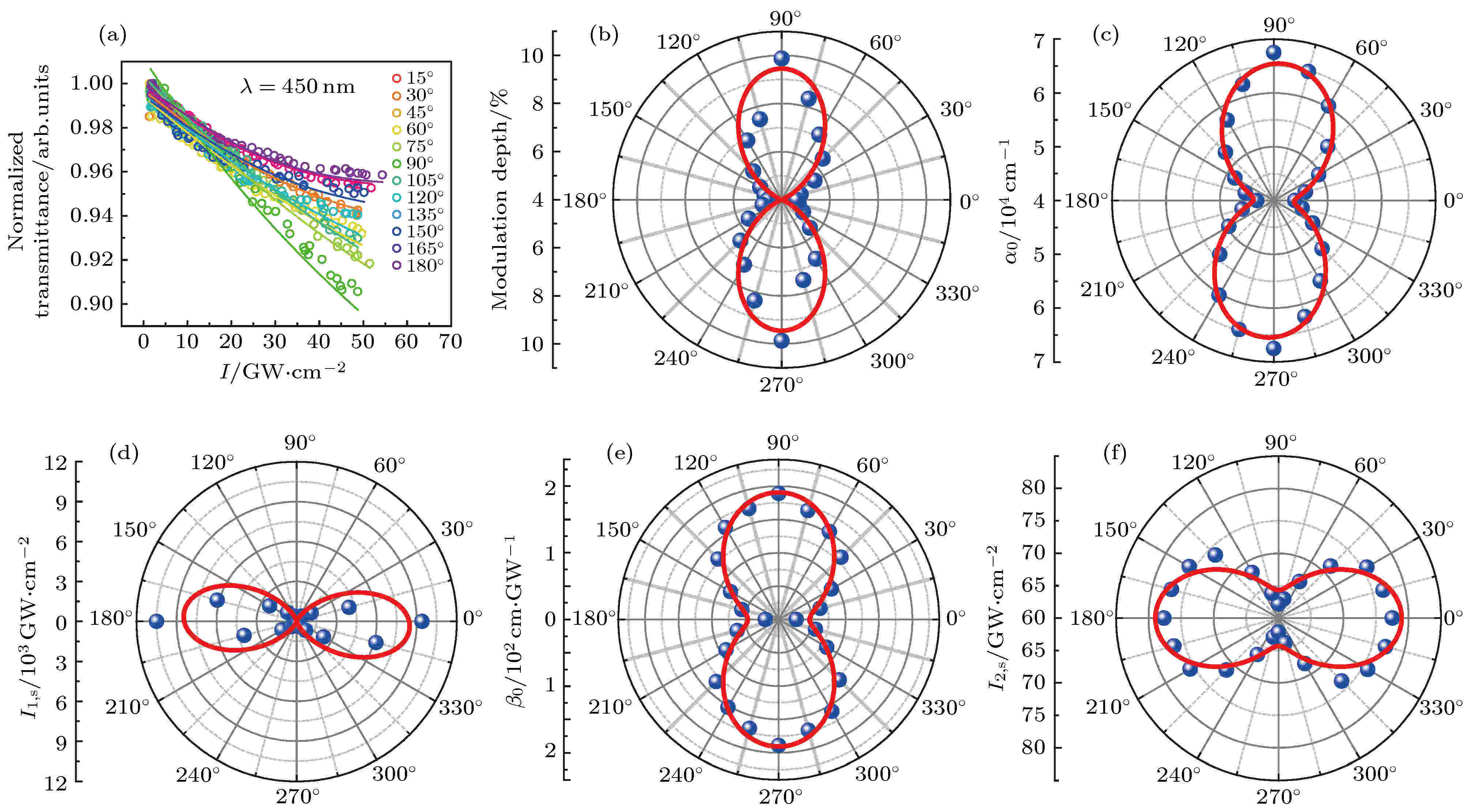 图 4 450 nm近共振激发下不同偏振方向的叠加态吸收实验结果 (a) I扫描实验结果, 圆圈表示实验数据, 实线表示激发态吸收拟合曲线; (b) 偏振相关的非线性调制深度极坐标图; (c) 偏振相关的线性吸收系数α0变化趋势极坐标图; (d) 饱和吸收的偏振相关饱和光强I1,s极坐标图; (e) 偏振相关的激发态吸收系数β0变化趋势极坐标图; (f) 激发态吸收的偏振相关饱和光强I2,s极坐标图
图 4 450 nm近共振激发下不同偏振方向的叠加态吸收实验结果 (a) I扫描实验结果, 圆圈表示实验数据, 实线表示激发态吸收拟合曲线; (b) 偏振相关的非线性调制深度极坐标图; (c) 偏振相关的线性吸收系数α0变化趋势极坐标图; (d) 饱和吸收的偏振相关饱和光强I1,s极坐标图; (e) 偏振相关的激发态吸收系数β0变化趋势极坐标图; (f) 激发态吸收的偏振相关饱和光强I2,s极坐标图Figure4. Experimental results of superposition state absorption of different polarization directions under 450 nm non-resonant excitation: (a) Results of the I-scan experiment. The circles indicate the experimental data, and the solid lines indicate the excited state absorption curve: (b) polarization-dependent non-linear modulation depth polar plot: (c) polar plot of the change in polarization-dependent linear absorption coefficient α0; (d) polarization diagram of polarization-dependent saturated absorption intensity I1,s; (e) polarization diagram of the polarization-dependent excited state absorption coefficient β0; (f) polarized graph of polarization-dependent saturation light intensity I2,s absorbed by the excited state.
值得注意的是, 在450 nm近共振激发状态下, 线性吸收系数








| Polarization/(°) | α0/cm–1 | β0/cm·GW–1 | I1,s/GW·cm–2 | I2,s/GW·cm–2 | δT/% |
| 0 | 43909 | 175 | 9390 | 63 | 4.6 |
| 30 | 49631 | 157 | 1258 | 69 | 5.6 |
| 60 | 60289 | 65 | 409 | 75 | 7.1 |
| 90 | 67501 | 22 | 188 | 79 | 9.9 |
| 120 | 57266 | 81 | 469 | 76 | 6.8 |
| 150 | 48345 | 158 | 2333 | 68 | 5.0 |
| 180 | 43173 | 176 | 10483 | 62 | 4.6 |
表2450 nm近共振激发偏振相关的I扫描非线性叠加态吸收参数的拟合结果
Table2.Fitting results of I-scan nonlinear superposition state absorption parameters related to 450 nm non-resonant excitation polarization
对比400与450 nm的波长处的偏振选择非线性光学响应, 它们的饱和吸收模式对偏振的依赖特性是类似的, 最大的区别在于线性吸收系数


由于GeSe2材料的光学非线性吸收在不同偏振下动态调制深度很大, 它将有潜力应用于偏振选择的非线性吸收型全光开关[42]. 目前, 研究者对全光开关的研究主要集中于两类: 一类是线性全光开关, 另一类则是非线性全光开关. 线性全光开关是利用光学干涉效应实现的. 而非线性全光开关则是利用了材料的非线性光学特性实现一束调制光对另一束被调制光的控制, 使得被调制光的状态可被识别为“开”或“关”. 近年来, 随着光计算和光学神经网络的兴起, 全光开关需要以更快地发展速度跟上时代的步伐. 二维材料在全光开关的应用中, 有两类主流的非线性光学解决方案, 一类是利用光克尔效应实现的全光开关[43,44], 另一类则是偏振选择的非线性吸收型的全光开关[24]. 其中, 光克尔效应型的全光开关一个较为明显的优势是可实现在高达18 GHz的频率下调制高速信号的波长转换. 对于各向异性材料GeSe2而言, 则适用于偏振选择的非线性吸收型的全光开关(后文简称偏振型全光开关)应用. 偏振选择型全光开关则以高达44%的调制深度差而凸显其优势[24]. 偏振型全光开关是利用一束不同偏振的调制光激发二维材料, 使之处于不同的非线性吸收状态, 进而改变信号光的透过率. 由于GeSe2是一类各向异性强的二维半导体, 且在非线性光学中表现出较好的性能. 在应用于全光开关时, 可以分别利用偏振方向沿着a轴和b轴的高脉冲功率的调制光对二维材料的非线性吸收状态进行调制, 进而改变信号光的透过率. 具体而言, 根据GeSe2的非线性吸收结果, 可以预测一种偏振全光开关的实现方案, 如图5所示: 利用格兰棱镜将调制光的偏振方向设置为沿x轴(a-轴)入射GeSe2, 此时将使得二维材料对信号光的透过率为“开”的状态; 另外, 偏振方向设置为沿y轴(b-轴)入射GeSe2时, 此时二维材料对信号光的透过率调制为“关”的状态. 通过该手段, 最后可利用GeSe2的各向异性特性来实现偏振型全光开关.
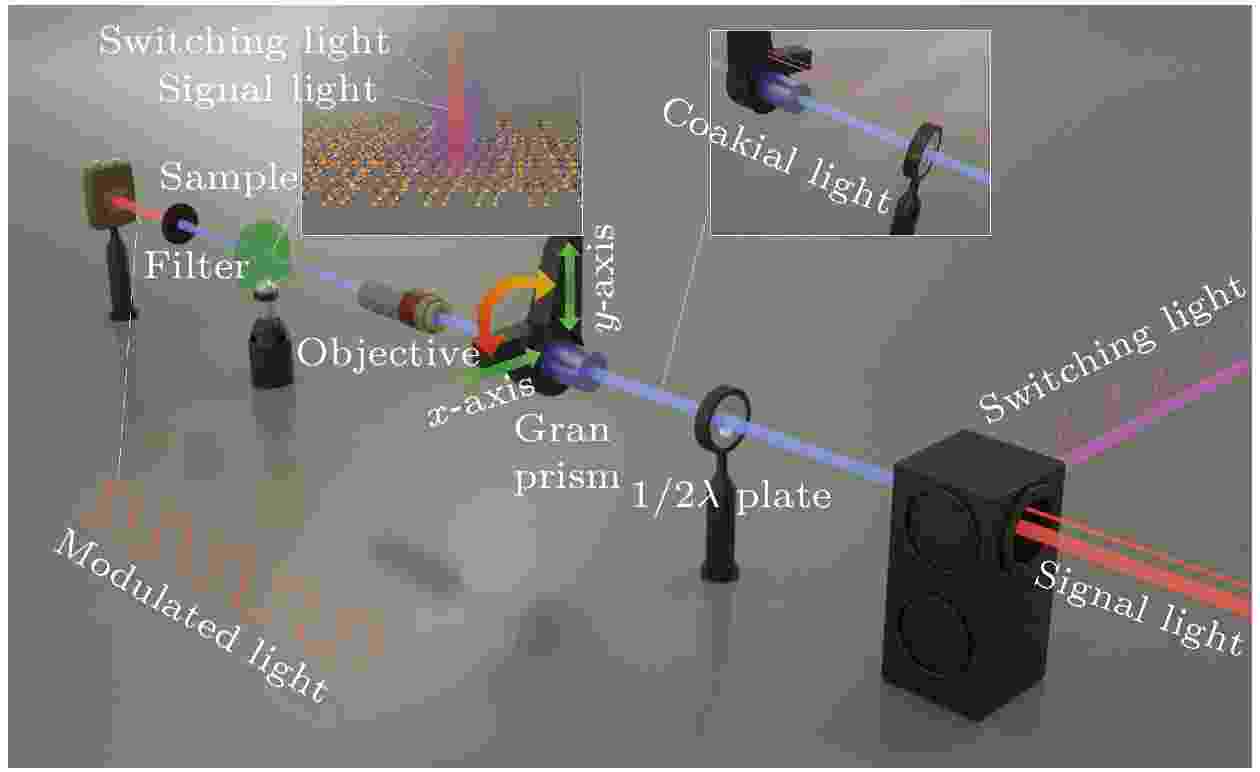 图 5 GeSe2偏振型全光开关的原理示意图
图 5 GeSe2偏振型全光开关的原理示意图Figure5. Schematic diagram of GeSe2 based polarized-dependent all-optical switching


